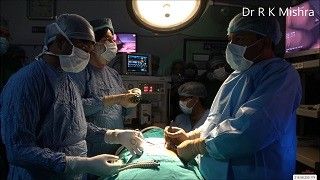How to tie Mishra's Knot for Laparoscopic Surgery
Add to
Share
297 views
Report
2 months ago
Description
In laparoscopic surgery, achieving secure and reliable intracorporeal knots is crucial for hemostasis, tissue approximation, and overall surgical success. Mishra’s Knot, named after Dr. R. K. Mishra, is a specialized technique designed to provide a strong, reproducible, and easy-to-learn knot for laparoscopic procedures. It is particularly useful in gynecologic and general laparoscopic surgeries where space is limited, and precision is essential. Key Features of Mishra’s Knot Provides high knot security with minimal slippage. Reduces suture handling time during intracorporeal knotting. Suitable for various suture materials including monofilament and braided sutures. Can be tied efficiently in confined laparoscopic spaces. Instruments Required Laparoscopic needle holder Graspers (optional) Laparoscopic scissors Appropriate suture (usually 2-0 or 3-0 absorbable for soft tissue, or 2-0 non-absorbable for ligation) Step-by-Step Technique Initial Loop Formation Hold the needle with the laparoscopic needle holder. Create a loop with the free end of the suture around the instrument or tissue to be ligated. First Throw Pass the needle through the loop. Tighten gently to form the first throw of the knot. Ensure the knot is snug but not overly tight to avoid tissue injury. Second Throw Reverse the direction of the loop and pass the needle through again. This creates a double-locking effect for improved knot security. Third Throw (Optional for Extra Security) Depending on tissue tension and suture type, a third throw can be applied. This adds an additional layer of security for high-tension areas. Final Tightening Carefully cinch the knot by pulling both ends simultaneously. Confirm that the knot is firmly seated and the tissue is approximated without excess tension. Cutting the Suture Trim the suture ends close to the knot using laparoscopic scissors. Leave a small tail (2–3 mm) to prevent knot unravelling. Tips for Successful Mishra’s Knot Maintain consistent suture tension to prevent loosening. Practice the knot in a dry lab or simulator before performing on patients. Always verify hemostasis after tying the knot. Use appropriate suture material to match tissue type and surgical requirement. Advantages over Traditional Laparoscopic Knots Faster and easier to master for beginners. Reduces risk of slippage in delicate or slippery tissues. Provides superior control in confined operative fields. Clinical Applications Ligation of ovarian pedicles or vessels Closure of small laparoscopic defects Suturing in laparoscopic myomectomy, hysterectomy, and bowel anastomosis Any situation requiring secure, intracorporeal knotting
Similar Videos






